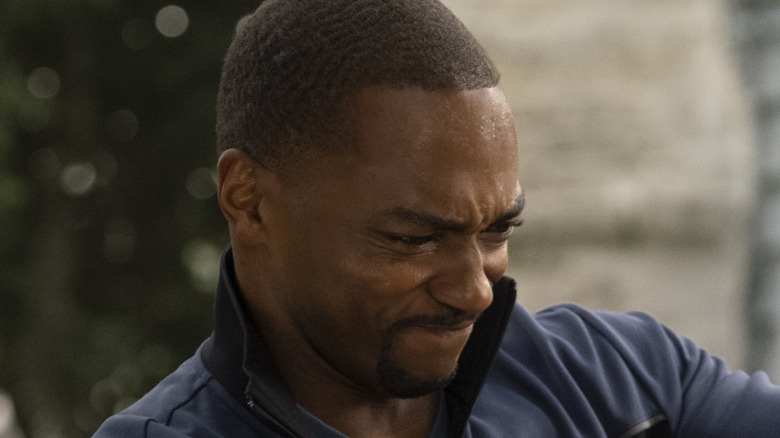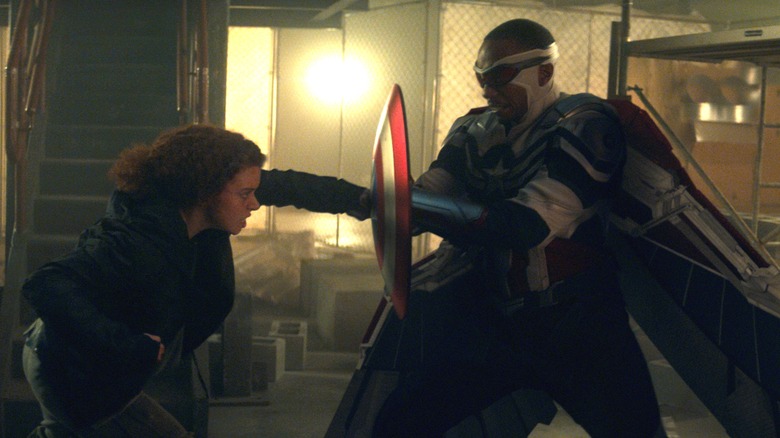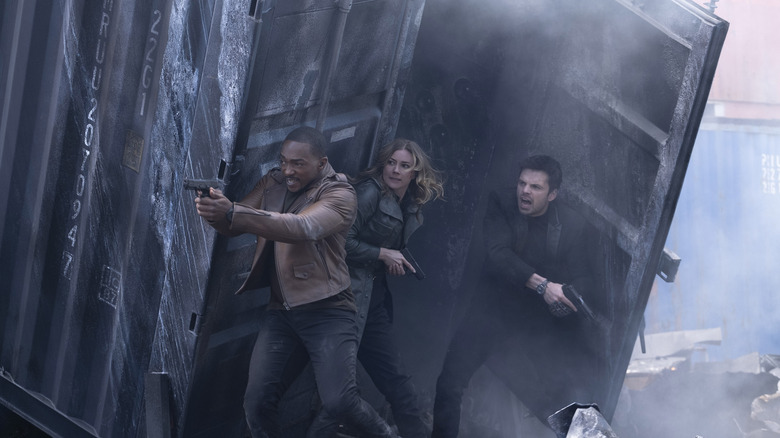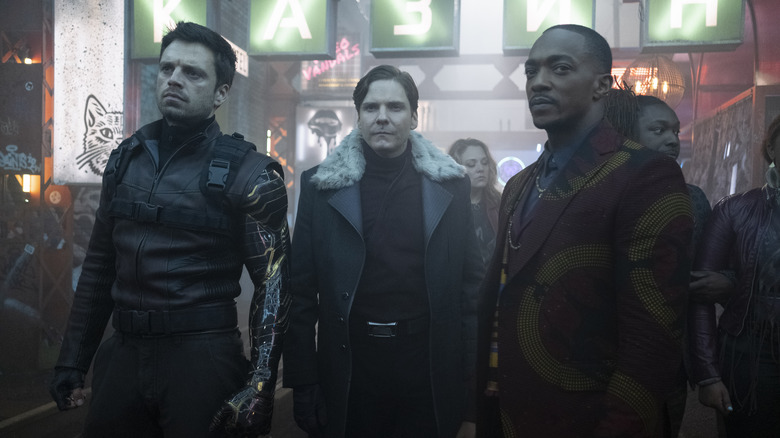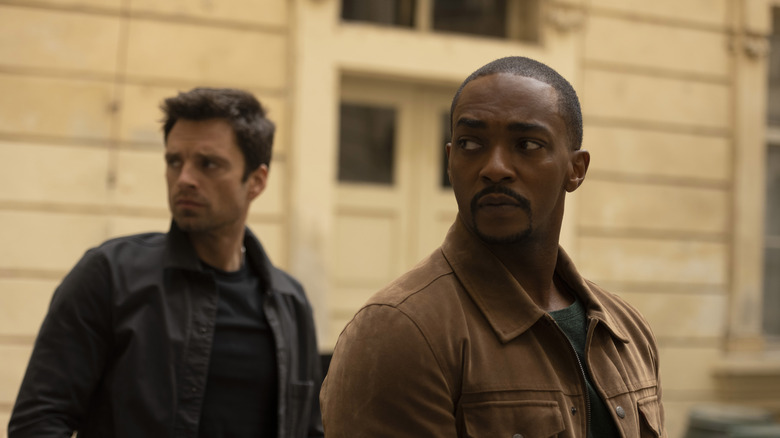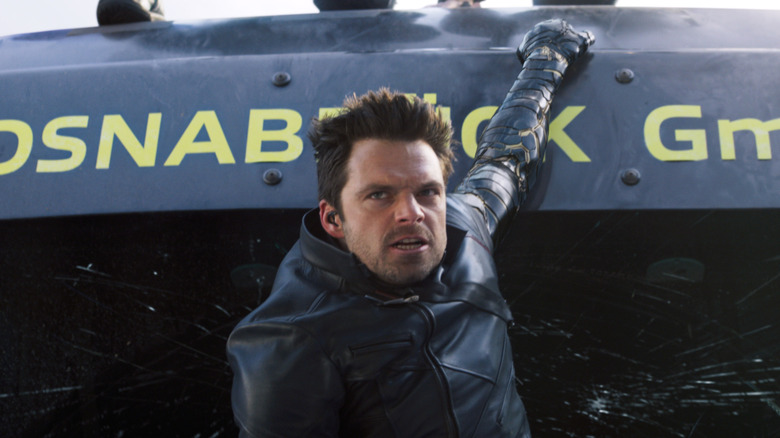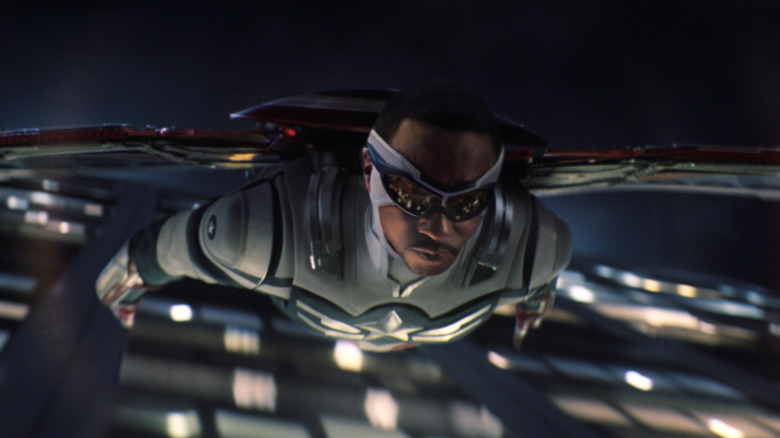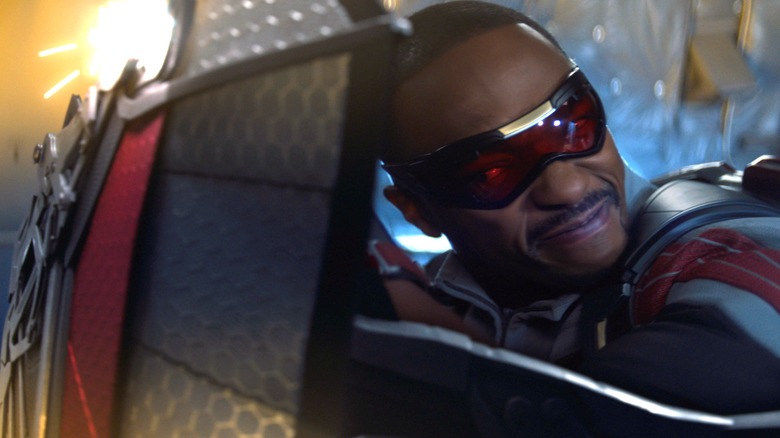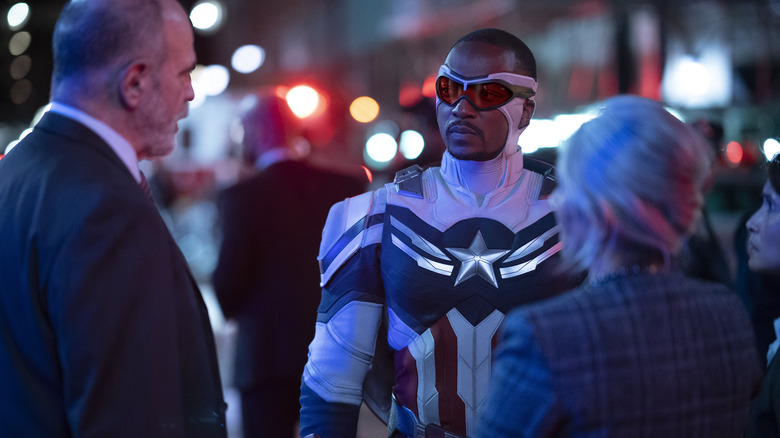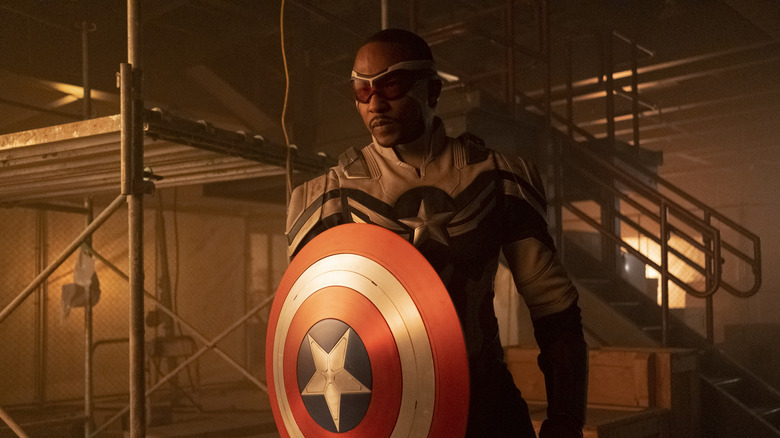Falcon And The Winter Soldier VFX Supervisor Eric Leven Reveals What It's Really Like Working With Anthony Mackie And Sebastian Stan - Exclusive Interview
It's easy to watch a film or series that's so seamlessly put together, you completely forget that a whole team of talented people work tirelessly behind the scenes to bring that level of precise, believable authenticity to the screen even when you're dealing with fantasy worlds and superheroes. But behind every stellar movie or TV show, there's a team of geniuses — costume designers, cinematographers, set designers, composers, and a VFX team — and these unsung heroes really make Hollywood shine. When it comes to "The Falcon and the Winter Soldier," without VFX supervisor Eric Leven, we wouldn't have Sam Wilson's mind-blowing flying sequences or epic, explosive battles.
With Leven helming the VFX on the series, there was no doubt that the final product would soar — especially working alongside cinematographer P.J. Dillon. Of course, this isn't Leven's first significant project. Having worked on a myriad of films like "Armageddon," "I, Robot," "The Lord of the Rings: The Two Towers," "Twilight," "Cloverfield," "Ted 2," and the "Twilight" saga, he's no stranger to massive productions. He also worked on TV shows like "A Series of Unfortunate Events" and "The Orville." It was only a matter of time before he got his superhero on.
During an exclusive interview, Looper spoke to Eric Leven, who dished on some of the biggest "Falcon and the Winter Soldier" fight sequences. He also revealed how Anthony Mackie's flying scenes came together, and he even gave Looper an exclusive behind-the-scenes story from the final episode.
Getting battle-ready
Can you walk us through what an epic battle sequence looks like from start to finish?
Yeah, I'll start with the hot potato desert chase, just because that was the first sequence that we really started on. So it starts with the script, and the script is a little bit vague and has things that ... I remember in the original script Malcolm Spellman had written this bit where there was a phone that was falling, and he wanted a very specific song playing on the phone as the whole thing was going on. That was pretty interesting. But then storyboards are made, so we start to get different camera angles and try to figure that stuff out.
But now we really need to figure out the timing and the action — how it all plays together. So then it goes to the visual effects department, and we start to pre-vis the whole scene. So lots of iterations of pre-vis are going on and on, because really this is where you have the time to make the scene work, working with the stunt department to figure out how we're going to do all the different bits that require stunts.
Freedom fighter
Then we shoot some practical stuff: Anthony Mackie on wires, fight scenes inside a real C-130 on the Air Force Base. Anthony Mackie on wires at the Air Force Base landing on the plane. Then there's a whole aerial unit with some of the most amazing wingsuit pilots you'll ever see. Just the talent of these people is incredible. Filming themselves while in free fall, doing multiple takes in air, which I thought was incredible — then starting to sort of edit all the different pieces together and figuring out what works, what doesn't, making it better. Going back and saying, "Okay, well, I see the scene now, and it doesn't quite work. Let's do this. Let's make this better. Let's do that." And just continuing to refine and refine and refine and refine.
And then, on top of that, now you've also got to make it look absolutely totally photo-realistic, which is a whole other challenge. So many, many, many people involved. I mean, the whole sequence probably took 16 months from start to finish. Yeah. For what's really eight to 10 minutes of film. So it was a massive undertaking, and that's just one of our major sequences. I think we had four or five in the whole show.
Winter Soldier or drama queen?
That's wild. How did Anthony Mackie's physical acting choices factor into the VFX design and final elements? And what about Sebastian Stan and Daniel Brühl as well?
I mean, Anthony, A, he's really collaborative, and he wants to make the scene as good as it can be, but he also brings years of this character to the table even when he flies. So I mean, there will be moments when the stunt team is sort of puppeteering him on wires, but I remember he was actually directing them, saying, "No, you need to move this way, and then I'll do this. And as you do that, I'll do this." He was able to bring a lot to his performances, even when he was just hanging on wires. Sebastian, it's funny, he's not necessarily ... he's very introspective about his character, and he really wants to know what makes Bucky tick and why he do this and how come Bucky would do this and would he really hold the shield this way?
And so it's actually really interesting to watch that process. Visual effects-wise for us, there's not as much for us to do with Sebastian, so it's really more about just making his arm look great. There were lots of conversations with me and Sebastian about ... because he has a prosthetic arm that goes from his shoulder to his wrist and then he has a prosthetic glove, and he also has a version with no fingertips because if he needs to grab something, he wants the fingerless version. And so I would always be bothering him like, "Oh, could you put the non-fingerless version on now? Because I don't want to have to paint out your fingertips." And he was, "Why do I have to? Robert Downey Jr. didn't have to wear anything in "Avengers 4." How come I have to wear this glove?"
A VFX legend
That's so funny. So you've done huge films and TV shows in almost every genre imaginable, from "Armageddon" and "The Lord of the Rings" to "I, Robot" and "Twilight." How does a massive fantasy movie like the "The Lord of the Rings" or a YA series like "Twilight" compared to a Marvel series like "The Falcon and the Winter Soldier?"
Well, I mean, for me personally, most of the stuff that I've done in the past has been very character-based. Even in "The Lord of the Rings," I was specializing in giant cave trolls. And "Twilight" was a lot about these wolves. You had to bring the personality, and it was really about making those characters believable as possible. But this was the first project where I got to do a giant aerial battle, the helicopter chases and trucks driving into construction pits, and that's something I've always wanted to do. So it was a real treat for me to be able to do this stuff.
I used to work with a second-year director, and he used to say, "Yeah, you want to work with metal, helicopters and trucks and jet packs and explosions." So that was really amazing. And then working for Marvel was amazing because they, unlike a lot of other studios, they are just constantly refining, refining, refining, and making stuff better and better and better all the way up to the very, very, very end of a project — in a way that a lot of other studios do not do. A lot of other studios have a plan, they execute the plan, and that's it.
Fire truck frenzy
Do you have any stories or surprising moments from any of those sets?
Goodness, probably. It's like when you finish a show, it's like you're the victim of a car crash, you sort of can't remember anything. Boy, I'll tell you, here's a fun story that no one knows about. So we're shooting at the pit, the construction pit, when Anthony Mackie is giving his big speech to all the senators. So there's really not a whole lot for us to do because all we're doing is fixing his costume, putting on his goggles. So between setups, I'm just kind of wandering around, and there was a fire truck there, and I'm like "I always wanted to hang out in a fire truck." So I climbed into the fire truck just to see what it was like, and apparently when you open a firetruck's doors, I guess when you're at the fire, they want to know who's coming and going from the firetruck, so the horn goes "errr errr" really loud.
So 200 people suddenly turn around and look like, "Who's this goofus hanging out in the fire truck?" And I was like, "Oh, sorry, sorry." And then they all go back to work, but now I'm stuck in this fire truck, and I don't want to open the door because I'm afraid the horn's going to go off again, so I had to roll down the window and climb out the window.
No trucking around
In "Marvel Studios: Assembled," we get a glimpse of what it was like crafting the VFX for the truck fight. Can you go into what that process looked like from start to finish from a VFX angle? And what was the biggest challenge for that sequence — and how did you make sure that the actors were safe?
Yeah, well, that was a really challenging sequence because a lot of the other big sequences were either clearly visual effects led or stunt-led. If it's a fistfight or big action where there's just a bunch of fighting, that's a stunt. If it's flying around and driving trucks over the edge of things, that's usually visual effects. This was sort of a nice combination of both. So the stunts brought a lot of ideas to their pre-vis, and we brought a lot of ideas to our pre-vis. It was really nice and collaborative and like, "Oh, let's do this, let's pull this from here and put this over there." And then there were a lot of rounds. It was a very challenging sequence, just story-wise, because how do you stage this fight with so many people on top of the trucks where no one can get on or get off?
And then what was challenging about it was that originally we had planned to just have a background replacement. We were going to shoot background plates in Atlanta. And then, as we started to put this stuff together, it just became very clear that this was not going to work. It just doesn't look very good. Atlanta does not look like the German Autobahn. So we ended up replacing the whole background in CG, and that becomes a very massive environment to build. As far as keeping the actors safe, most of the time, they were on a very low platform, probably only about three or four feet off the ground, surrounded by pads. And then for the big stunt beats where they needed to be on top of a full-size truck, those were usually either stunt doubles or they were wired in with little wires to make sure they couldn't fall off.
Sky diving and Falcon flying
We get a look at how the flying scenes comes together as well during the "Assembled" episode. Can you go through the process of melding the real-life skydiving action with Anthony's blue screen sequences — and explain a bit how the realism and the VFX mesh together?
Well, I think as far as the realism, I think every visual effects supervisor will tell you the same thing, which is if you can do it for real, you should do it for real. Even if it doesn't totally work, you want to at least see what it's supposed to look like for real. So that's how we treated a lot of our skydiving bits. For one reason or another, I mean, all the skydiving footage was incredible, but things changed in the edit — or maybe a performer didn't do exactly what they were supposed to do in the air, so they needed to be replaced in CG. But at least we now had a reference of what a person looks like as they're flying across the sun at 10,000 feet, for example. So that was unbelievably important.
And as soon as you have footage of people jumping out of a plane that you're inner cutting with a shot of Anthony Mackie on a blue screen, well, if the blue screen composite looks good and you put them in the right world and that just cut with something that you know is real, maybe you start to question what's real throughout the entire sequence. And that's the goal — to just make it feel as realistic as possible.
So the other trick that was important with Anthony's stuff for us was making sure that the way we filmed that was something that was filmable in real life. A lot of these, I call it like video game cinematography, where you just get these impossible camera angles. And they're beautiful and gorgeous, but they are not physically able to be done in the real world. So we wanted to constrain that footage to something that was realistic because then that sort of influences how the whole scene comes together. And obviously, those are rules you can break when you need to get really cool shots. But we tried to limit the video game stuff as much as possible.
A trick of the light
I remember watching that first episode flying scene, and I was like, "How the heck did they do this? This is incredible."
Yeah. I mean, it's a testament to all the VFX people who worked on that scene, but I mean that the whole desert environment is completely CG the whole time. We never actually filmed in a desert.
That's so incredible. So what were you looking for in each of those areas when deciding what would end up in the final product, in terms of the flying? And what was the communication like between you, the on-set light designer, and the director of photography to work together to create this photo-realistic flight?
Well, it was interesting. I mean, one of the mandates that we talked about was making sure that we filmed all the blue screen stuff outside, so we got as much actual sunlight as possible. A lot of times, that stuff is shot on a blue screen stage inside, and you try to light it. It looks like sunlight, but it's very difficult to duplicate sunlight on a stage. So that was a conversation we had early on, was to make sure that stuff was photographed outside as much as possible.
You're trying to be very cognizant of lighting direction and making sure that you're lighting everyone from the right side. But honestly, a scene like that is so confusing, and so it will change in the edit that maybe you're making guesses that are going to be correct, or maybe they'll be incorrect later anyway. And then yeah, working with Kari Skogland, the director, who'd really never worked in a big giant action scene like this before trying to walk her through the process of ... she was really concerned about Anthony's performance, but we were very concerned about like, "No, we have to get this shot, it's very specific." So working collaboratively together with all those people actually resulted in a lot of great stuff.
Tailoring a superhero
Definitely. How much time did it take to fix Sam's cowl from the Cap episode — that Cap suit — and what will that process look like in films in the future or possibly even another series? Because that was just one episode. And do any of the other super suits sort of have that challenge?
On this show, I don't think there are any other super suits that had that issue. It's really just Cap's suit. I know that other Marvel shows, there are constantly things that need to be fixed, boots need to be touched up, whatever. And that's just the nature of them designing something that's not physically doable. For example, you have to have the scene, you have to have a way to put this on, but we don't want to see the scene. So, I mean, it was challenging. I mean, that's very detail-oriented work to make it look just right. Your brain knows when it's not right. But it is sort of once you get it once you kind of know where to go.
And as far as how it ends up in the future, I don't know. It's a good question. I think that Michael Crow, the costume designer, he knew this was going to be an issue based on what they wanted versus what he was able to physically do. He knew that we'd have touch it. And whether they'll address that in the future, I'm not sure. I mean, you always see the costumes sort of evolving from show to show, so maybe he'll evolve them.
Finding the good
How long did it take to make those adjustments?
I mean, relatively speaking, not a lot. I mean, it's funny because there's a whole team of people who were working on this at the VFX facility, and I basically see the before and then like, "Oh, it's done. That looks fantastic." But compared to making a photo-realistic truck drive off the edge of a road, it seemed like it was a blessing.
That's fair. "Assembled" also covered some challenges in terms of filming locations due to COVID and the earthquakes in Puerto Rico. How did you sort of pivot and navigate some of those unexpected challenges when a lot of things had already been mapped out?
I mean, luckily for us, it didn't really affect visual effects too much. Most of our work is done in post, really. So we're able to sort of roll with the punches a little bit and all of our big action sequences. Nothing really was going to be in Puerto Rico for us, for example. There was a lot of stunt stuff and a lot of art department stuff, but visual effects-wise it didn't really affect us. And frankly, the extra time that we were able to get from COVID was a blessing because when we were shut down for five or six months, we were able to go back and retool and really redo the sequences to make them as amazing as possible.
Fans can binge "The Falcon and the Winter Soldier" on Disney+, and the "Marvel Studios: Assembled" episode on the series is also available on the streaming platform.
